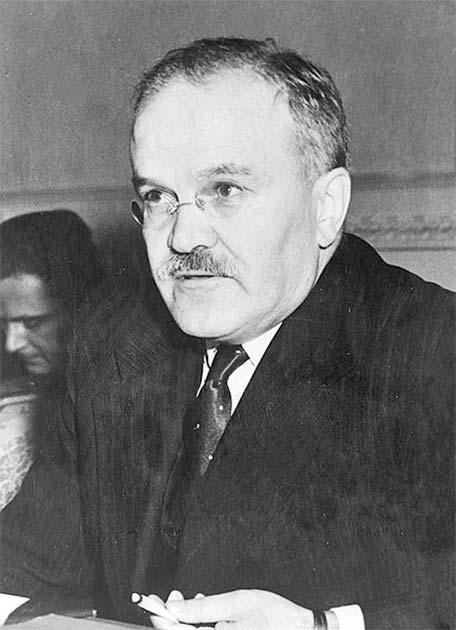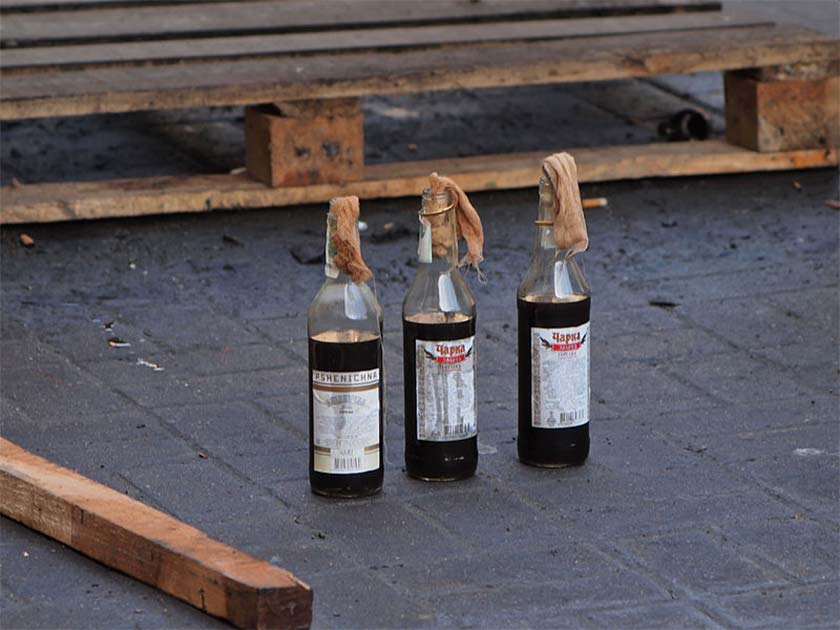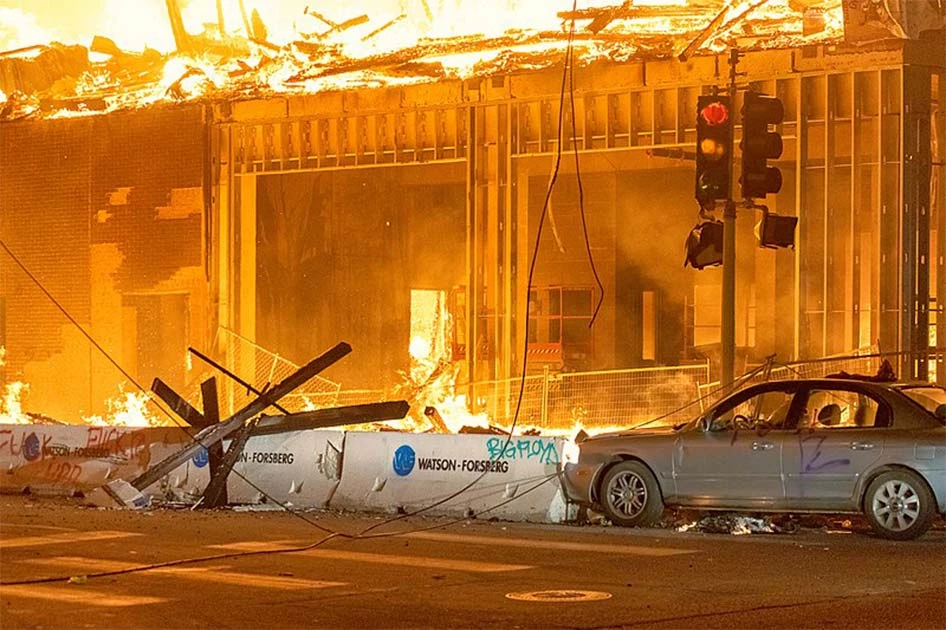The Molotov cocktail is one of the all-time greats of improvised weaponry. A hand-thrown incendiary weapon, generally made by filling a glass bottle or jar (any frangible container would work, but glass is traditionally used) with flammable substances, its effectiveness as a tool of protest cannot be overstated.
The fuse is typically a cloth wick from fabric or old rags soaked in gasoline and then sealed with a cork or lid. The fuse is then lit on fire, and someone throws the device, which will shatter upon impact with the ground, buildings, tanks, etc. The breaking of the bottle causes the flammable liquid to ignite, resulting in fires.
Molotov cocktails are easy to make, and they are used by rioters, terrorists, criminals, “urban guerrillas,” and even out-of-control sports fans when their team doesn’t win. The military also uses Molotov cocktails in the event of a shortage of military-issued weapons in the field.
While these devices are considered improvised, large numbers of Molotov cocktails are made in advance of combat. The most recent example of the use of Molotov cocktails was the use of them by volunteer units during the 2022 Russian invasion of Ukraine.
Not a Cocktail, Then?
The first known use of the Molotov cocktail as we know it today was in 1936 during the Spanish Civil War. Yes, although this bomb is commonly known as the Molotov cocktail, it did not originate in Russia, nor did the Soviet foreign minister Vyacheslav Molotov invent the cocktail that shares his name.

The Molotov cocktail has gone by other names such as petrol bomb, bottle bomb, burn bottle, and “the poor man’s grenade”. During the Spanish Civil War, these petrol bombs and fire bottles were thrown by soldiers of the Spanish National forces used against Soviet T-26 tanks near the city of Toledo.
At this point it didn’t have a title: the Molotov cocktail finally got its name during the Winter War between the Soviets and Finland in 1939. During this Winter War, the Soviet Union and foreign minister Vyacheslav Molotov produced propaganda to cover up what the Red Army was doing in Finland.
- Emotional Trauma: The Murray Experiment and the Unabomber
- Panzerknacker: The Nazi way to Blow Up Tanks
On state radio, Molotov lied and told the public that the planes dropping incendiary bombs onto the country were not bombs at all. The Soviet Union was performing “airborne humanitarian food deliveries” for their “starving” neighbors…
The Finns started sarcastically calling the cluster bombs that the Soviet Union would drop “Molotov bread baskets.” The Finns were not subtle about their feelings towards Molotov, and when bottle bombs were created to destroy Soviet tanks, the Finns called the bomb the “Molotov cocktail” because it was “a drink for Molotov to go with his food parcels.”
While the Finns gave the Molotov cocktail its name, the Finish military does not call them this themselves. They refer to them as “burn bottles” or polttopullo.
Molotov cocktails are seen as legitimate weapons by militaries across the globe. The United States had even classified the Molotov cocktail as a frangible grenade and created the Frangible Grenade M1, which was a series of Molotov cocktail-inspired grenades that were used in 1942. These Molotov cocktail-like devices were factory produced and used in World War II because the US entered the war late and had low stocks of arms and munitions.
Straightforward and Devastating
What makes Molotov cocktails such popular devices is that they are so easy to make. Unlike other kinds of homemade bombs, a Molotov cocktail is stable; it won’t accidentally explode during the process of making it.

There is no specific flammable liquid that must be used to create a Molotov cocktail; anything that will combust will do. Molotov cocktails can be made using gas or diesel fuel (the popular method), acetone, rubbing alcohol, jet fuel, turpentine, and methanol. These other fluids can also be added to a cocktail with petrol as well for a little extra spice.
While a fire bomb on its own can do some damage, in order to really maximize the flames, thickening agents are sometimes added to the contents of the bottle. Tar, petroleum jelly, motor oil, rubber cement, and the infamously flammable compound nitrocellulose can be used to make the burning liquid adhesive, so it is harder to remove or to put out.
- The Bat Bombs of WWII: Presidentially Approved, Totally Crazy?
- Wartime Sabotage in a Neutral Country? The Black Tom Explosion
Civilians have used Molotov cocktails during major conflicts and riots. During the 1992 Los Angeles riots, in response to the officers who beat Rodney King being acquitted of their crimes, Molotov cocktails were thrown at the police and riot squad.
Another similar situation of inappropriate, excessive force by police was the fatal shooting of Michel Brown, which sparked what was known as the Ferguson riots in 2014. Some protestors created and used Molotov cocktails against the police.
During the 2020 George Floyd protests in the US, looters and rioters used Molotov cocktails to cause more chaos or aid in robberies. Buses and cars were attacked with Molotov cocktails during the government protests in Bangladesh in 2014, which resulted in the deaths of several innocent people.

The problem with Molotov cocktails and civilians is that because they are so easy to make and can be produced in bulk, they can show up in any protest or riot that occurs. Molotov cocktails are dangerous and can cause large amounts of damage.
With the gun crisis that exists in the United States, the addition of Molotov cocktails to attacks could make a tragedy even worse. Dealing with fire, an explosion, broken glass as well as an active shooter increases the amount of chaos which puts more innocent victims’ lives at risk.
The Law
Because Molotov cocktails are considered incendiary devices, they are illegal to possess and manufacture in many countries. In the United States, the Bureau of Alcohol, Tobacco, Firearms, and Explosives (ATF) classifies Molotov cocktails as “destructive devices,” which means they are regulated under the National Firearms Act.
While anyone can make a Molotov cocktail, it doesn’t mean it is okay to create one. Producing or being in possession of Molotov cocktails can put you in jail for a very long time.
Top Image: Molotov Cocktails are an extremely effective improvised weapon. Source: Eneas De Troya / CC BY 2.0.